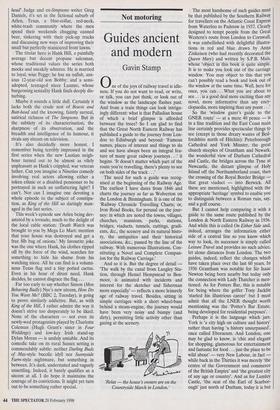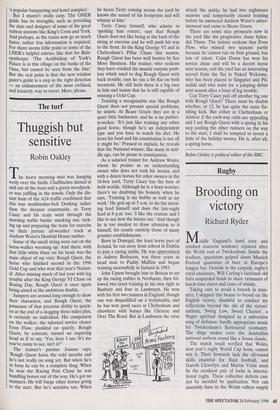Not motoring
Guides ancient and modern
Gavin Stamp
The need for such a guide was recog- nised at the beginning of the Railway Age. The earliest I have dates from 1846 and charts the journey as far as Wolverton on the London & Birmingham. It is one of the `Railway Chronicle Travelling Charts; or, Iron Road Books, for perusal on the jour- ney: in which are noted the towns, villages, churches, mansions, parks, stations, bridges, viaducts, tunnels, cuttings, gradi- ents, &c., the scenery and its natural histo- ry, the antiquities and their historical associations, &c., passed by the line of the railway. With numerous Illustrations. Con- stituting a Novel and Complete Compan- ion for the Railway Carriage.'
And so it is. But the degree of detail `The walk by the canal from Langley Sta- tion, through Hemel Hempstead to Box- moor, is animated with incidents and interest for the sketcher and fisherman more especially' — reflects a more leisurely age of railway travel. Besides, sitting in simple carriages with a short wheel-base behind a steam-engine, the journey would have been very noisy and bumpy (and dirty), permitting little activity other than gazing at the scenery.
Relax — the house's owners are on the Countryside March in London,' The most handsome of such guides must be that published by the Southern Railway for travellers on the Atlantic Coast Express from Waterloo to Padstow in 1937. Clearly designed to tempt people from the Great Western's route from London to Cornwall, it was embellished with delightful illustra- tions in red and blue drawn by Anna Zinkeisen (who had recently decorated the Queen Mary) and written by S.P.B. Mais, whose 'object in this book is quite simple. It is to make you look out of the carriage window. You may object to this that you can't possibly read a book and look out of the window at the same time. Well, here for once, you can ... What you are about to see ... is a good deal more exciting than any novel, more informative than any ency- clopaedia, more inspiring than any poem ..
So the 'window gazer's guide to the GNER route' — at a mere 40 pence — is in a fine tradition and the East Coast main line certainly provides spectacular things to see (except in those dreary wastes of Bed- fordshire north of Hitchin): Peterborough Cathedral and York Minster, the great church steeples of Grantham and Newark, the wonderful view of Durham Cathedral and Castle, the bridges across the Tyne at Newcastle, the distant glimpse of Holy Island off the Northumberland coast, then the crossing of the Royal Border Bridge that great viaduct — into Berwick. All these are mentioned, highlighted with the appropriate 'heritage' symbol to enable you to distinguish between a Roman ruin, say, and a golf course.
But I cannot help comparing it with a guide to the same route published by the London & North Eastern Railway in 1936. And while this is called On Either Side and, indeed, arranges the information either side of a central line so you know which way to look, its successor is simply called Leisure Travel and provides no such advice, let alone distances from London. The two guides, indeed, reflect the changes which have taken place over the last 60 years. In 1936 Grantham was notable for Sir Isaac Newton being born nearby but today only the connection with Lady Thatcher is men- tioned. As for Potters Bar, this is notable for being where the golfer Tony Jacklin `started his illustrious career' but I must admit that all the LNER thought worth mentioning was the 'Potter's Bar Estate, being developed for residential purposes'.
Perhaps it is the language which jars. York is 'a city high on culture and history' rather than having 'a history unsurpassed', once called Eboracum. And London, one may be glad to know, is 'chic and elegant for shopping, glamorous for entertainment and fantastic for food ... just the place to be wild about' — very New Labour, in fact while back in the Thirties it was merely 'the centre of the Government and commerce of the British Empire' and `the greatest city of any age or country'. And as for Lumley Castle, 'the seat of the Earl of Scarbor- ough' just north of Durham, today it is but `a popular banqueting and hotel complex'. But I mustn't really carp. The GNER guide has its strengths, such as providing the date and designer of some of the great railway stations like King's Cross and York. And perhaps, as the trains now go so much faster, rather less information is required. For there seems little point in some of the LNER's helpful entries, like that for Bish- opsthorpe: 'The Archbishop of York's Palace is in this village on the banks of the Ouse, but cannot be seen from the line.' But the real point is that the new window gazer's guide is a step in the right direction — an enhancement of the most civilised, and leisurely, way to travel. More, please.



























































 Previous page
Previous page